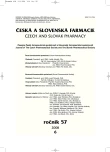Optimization of the extraction method for the determination of methadone and its metabolite EDDP in urine by gas chromatography
Authors:
R. Horáková; J. Valentová; I. Pechová; F. Devínsky
Authors‘ workplace:
Univerzita Komenského Bratislava, Farmaceutická fakulta, Katedra chemickej teórie liečiv
Published in:
Čes. slov. Farm., 2008; 57, 265-268
Category:
Original Articles
Overview
The present study aimed to develop a suitable extraction method for the determination of methadone and it’s metabolite EDDP in human urine by gas chromatography with a nitrogen–phosphorus detector (NPD). The extraction method was optimized in an effort to receive the most satisfactory yield of the mentioned compounds from human urine. The highest yields were obtained by alkaline extraction (~ pH 9) with dietylether. Proadiphene (PA) was used as the internal standard. The most efficient yields were determined as follows: 91 ± 5 % for methadone (MTD) and 86 ± 5 % for its metabolite EDDP. The detection limit (LOD) of MTD was 8 ng/ml, for EDDP 23 ng/ml, and the limit of quantification (LOQ) was 27 ng/ml of MTD and for EDDP 77 ng/ml. The accuracy of this method inter day was found for MTD 1.1–2.32 %, for EDDP 7.3–9.3 % and intra day for MTD it was 9.1–13.7 %, for EDDP 4.7–8.7 %. The suitability of the developed method was checked for routine monitoring of MTD and it’s metabolite EDDP in human urine for 5 different samples taken from methadone maintenance program.
Key words:
methadone (MTD) – 2-ethylidene-3,3-diphenyl-1,5-dimethylpyrrolidine (EDDP) – urine – GC/NPD
Sources
1. Pothier, J., Galand, N.: J. Chromatogr. A, 2005; 1080, 186–191.
2. Whelan, G., Lintzeris, N., McDonough, M. et al.: Methadone guidelines prescribers and pharmacists. 1. vydanie. Melbourne: State of Victoria, 2000; 7–15.
3. Kreek, M. J., Ann, N. Y.: Acad. Sci., 2000; 909, 186.
4. Eap, CH. B., Buclin, T., Bacmann, P.: Clin. Pharmacokinet., 2002; 41, 1153–1193.
5. Habrdová, V., Balíková, M.: Chem. Listy, 2002; 96, 1006–1009.
6. Misztal, G.: Acta Pol. Pharm., 1990; 47(5–6), 5–8.
7. Digiusto, E., Seres, V., Bibb, Z. A., Batey, R.: Addict. Behav., 1996; 21, 319–329.
8. Adams, P. S., Haines-Nutt, R. F.: J. Chromatogr., 1985; 329, 438–440.
9. Pierce, T. L., Murray, A. G. W., Hoff, W.: Science, 1992; 30, 443–447.
10. Choo, R. E., Murphy, C. M., Jones, H. E., Huestis, M. A.: J. Chromatogr. B, 2005; 814, 369–373.
11. Quintela, O., López, P., Bermejo, A.M., López-Rivadulla, M.: J. Chromatogr. B, 2006; 834, 188–194.
12. Müller, K.: Pharmazie, 1983; 38, 596–601.
13. Georgakopoulos, C. G., Kiburis, J. C.: Anal. Chem., 1991; 63, 2021–2004.
14. Schmidt, N., Still, R., Brune, K., Geisslinger, G.: Pharm. Research, 1993; 10 (3), 441–444.
15. Charotti, M., Marsili, R.: J. Microcol., 1994; 6, 577–580.
16. Balíková, M.: Remedia 1995; 5, 211–216.
17. Cooper, G. A. A., Oliver, J. S.: J. Anal. Toxicol., 1998; 22, 389–392.
Labels
Pharmacy Clinical pharmacologyArticle was published in
Czech and Slovak Pharmacy

2008 Issue 6
Most read in this issue
- Possible effects on the liberation of alaptid from dermal semisolid preparations
- Studies of local anesthetics Part 185: Thermodynamic parameters of heptacainium chloride in the solution of NaBr
- Optimization of the extraction method for the determination of methadone and its metabolite EDDP in urine by gas chromatography
- The effect of lipophilic carrier concentration on hydrophilic-lipophilic matrix systems characteristics
